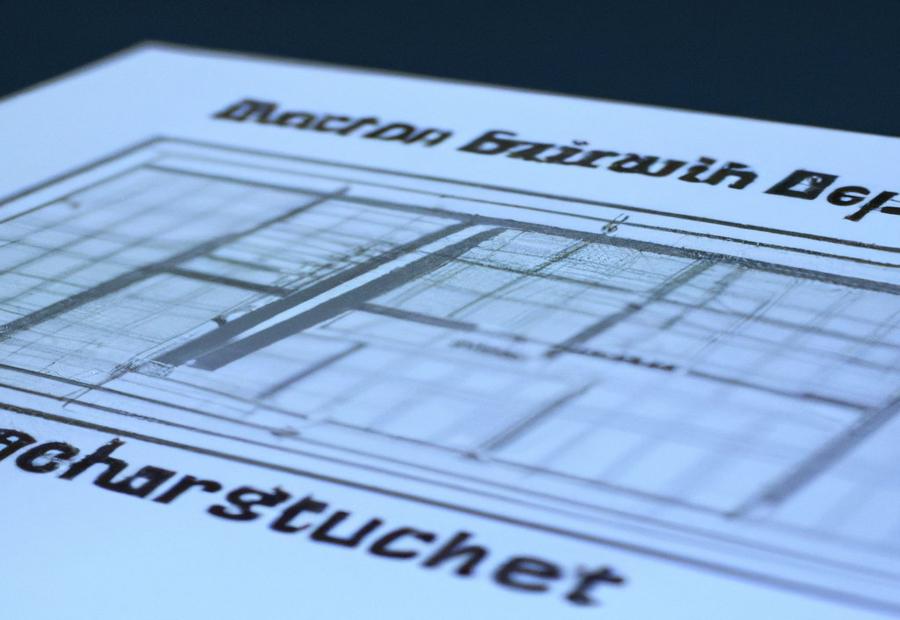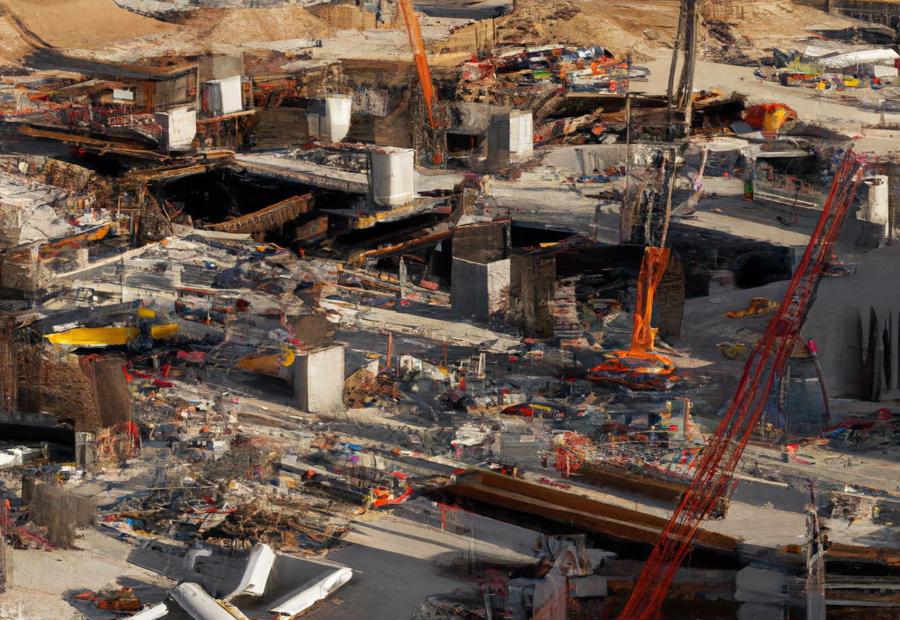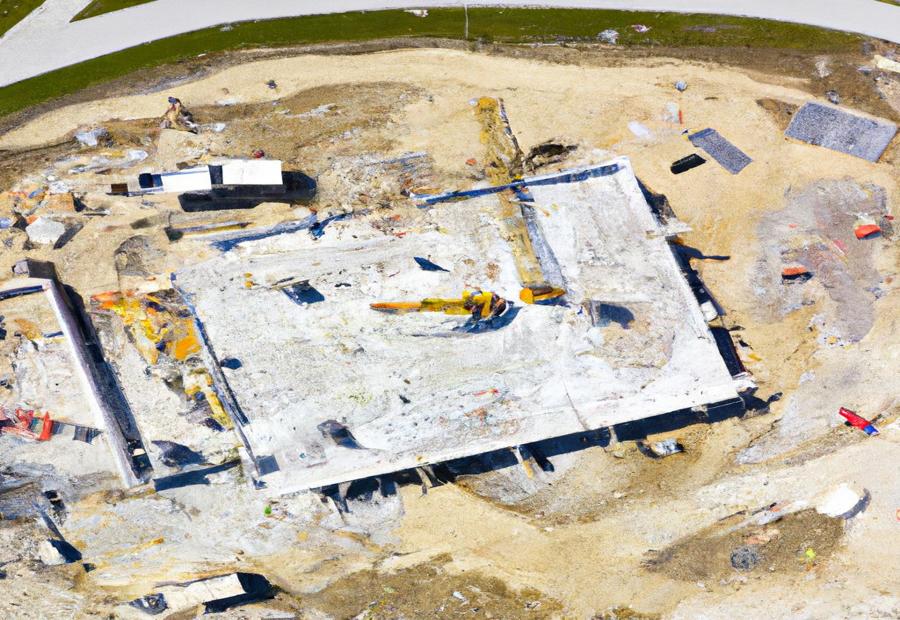Key takeaway:
- A successful construction plan is essential for any construction project as it helps define the project scope and objectives, allocate resources effectively, and implement risk assessment and mitigation strategies.
- Involving key stakeholders and conducting thorough research and analysis are crucial steps in creating a successful construction plan.
- Regularly monitoring progress, adapting to unexpected challenges, and incorporating feedback and continuous improvement are important strategies for implementing the construction plan.



Photo Credits: Build-Wire.Com by Steven Perez
A successful construction plan is crucial for project completion. In this section, we’ll explore the definition and purpose of a construction plan and the benefits it brings. Backed by reliable sources, we’ll provide valuable insights and statistics that highlight the importance of having a well-executed construction plan. Let’s dive in and discover key strategies and essential tips that can contribute to the success of any construction project.
Definition and Purpose of a Construction Plan
A construction plan is essential. It outlines details & steps needed to complete a project. It serves as a guide for all involved, providing clear & organized framework. Its purpose? Ensure effective communication, coordination & control throughout the construction process.
It defines project goals & expectations, outlining deliverables & milestones. It also identifies resources, such as materials, equipment & labor – plus allocation & scheduling.
The importance of a construction plan can’t be overstated. It sets the foundation for successful project management by providing clarity & direction. It helps minimize confusion, miscommunication & errors. It enables efficient resource utilization.
To create a successful plan, tips should be followed:
- Define project scope & objectives.
- Involve key stakeholders from the beginning.
- Thorough research & analysis.
- Create a detailed project schedule.
- Allocate resources effectively.
- Risk assessment.
- Establish communication channels.
- Monitor & track progress.
- Be adaptable to unexpected challenges & changes.
- Incorporate feedback & look for opportunities to improve.
- Utilise software solutions.
Benefits of Having a Successful Construction Plan
A successful construction plan brings many advantages for project success. It provides a roadmap that all stakeholders understand, which encourages effective communication and collaboration. This roadmap is one of the key benefits of a successful construction plan.
Plus, it allows resources like materials, manpower and equipment to be used efficiently. This streamlines operations, limits wastage and saves money – another key benefit.
Also, it includes risk assessment and prevention strategies, meaning potential challenges can be identified and managed, reducing project delays. This is an important part of a successful construction plan.
Moreover, it ensures safety and compliance, by planning out each phase of construction. Potential safety hazards can be spotted early and dealt with, improving worker safety and avoiding accidents. Also, regulatory requirements are followed, avoiding potential legal issues.
Case studies back up the importance of a successful construction plan. Studies on large-scale infrastructure projects showed lower cost overruns and schedule delays with comprehensive plans. In the residential construction sector, projects with detailed plans got higher customer satisfaction and fewer post-construction issues.
In short, a construction plan is like a map through the jungle – it keeps you on track and saves you from getting stuck in a quicksand of mistakes.
Understanding the Importance of a Construction Plan



Photo Credits: Build-Wire.Com by Brandon Green
Understanding the importance of a construction plan is crucial in ensuring the success of any building project. In this section, we will explore the definition and purpose of a construction plan, as well as the various benefits it brings to the project. Stay tuned to discover the essential role this plan plays in streamlining construction processes, maximizing efficiency, and minimizing costly errors.
Definition and Purpose of a Construction Plan
A construction plan is a must-have document. It outlines the steps and processes needed for a successful construction project. It serves as a guide for all stakeholders, giving clear instructions and direction. Its purpose is to make sure the project runs efficiently, effectively, and within the scope, schedule, and budget. A construction plan sets the foundation for a well-structured approach by defining project objectives and deliverables.
It’s important to have a construction plan. It’s like a roadmap that helps everyone work towards the same goal. It offers transparency and ensures everyone understands the objectives. It also serves as a communication tool between contractors, engineers, clients, and authorities.
Research and analysis are vital when creating a plan. You need to study site conditions, environmental factors, building codes, market trends, materials, labor, and cost estimations. This data gives you valuable insights.
To have a successful plan, set up a project schedule with key milestones and deadlines. This helps coordinate activities between teams or contractors. Establishing good communication channels also promotes open dialogue and collaboration.
A successful construction plan is like having a blueprint for success. It’s the foundation that keeps your project from crumbling.
Benefits of Having a Successful Construction Plan
A successful construction plan offers many advantages. It provides a roadmap for everyone involved, allowing for better coordination and communication. It improves efficiency by organizing tasks and activities. It also helps in budget control with risk assessment strategies. Quality control measures are defined to ensure the project meets expectations. This leads to client satisfaction and strengthens relationships. Additionally, it encourages collaboration among stakeholders.
For example, the Empire State Building was completed in just 14 months due to precise planning and coordination. Detailed blueprints, engineering solutions, and scheduling were used. This shows the importance of having a successful construction plan. To build a skyscraper, clear objectives, stakeholders, research, and resource allocation are needed.
Essential Tips for Creating a Successful Construction Plan



Photo Credits: Build-Wire.Com by George Adams
Crafting a successful construction plan requires careful attention to detail and strategic decision-making. In this section, we will uncover essential tips that lay the foundation for a well-executed project. From clearly defining the project scope and involving key stakeholders to conducting thorough research and analysis, we will explore the key elements that contribute to a successful construction plan. By following these tips, you can ensure that your construction project is set up for success from the very beginning.
Clearly Define the Project Scope and Objectives
To craft a successful construction plan, you must define the project scope and objectives. These include the goals, boundaries, and desired outcomes. This helps all parties work towards a common goal.
You must also determine what needs to be achieved within the timeframe and resources available. This includes deliverables, tasks, and milestones. Defining the project scope helps manage expectations and prevent deviations.
Accurately defining the objectives allows for effective communication among stakeholders. It creates a shared understanding of what needs to be done, so potential conflicts can be minimized.
It also enables efficient resource allocation. Resources can be allocated to specific objectives, so productivity can be optimized and waste minimized.
So, get ready to wrangle those stakeholders!
Identify and Involve Key Stakeholders
Identifying and involving key stakeholders is crucial for a successful construction plan. Spot those individuals or groups who have a vested interest in the project and engage with them from the start. Grasp their perspectives and objectives, incorporate input into decisions, and maintain communication throughout the project. This way, you can guarantee that their requirements and worries are addressed and blended into the whole plan.
Conduct Thorough Research and Analysis
Research and analysis is a must for construction planning. It involves gathering and evaluating facts and figures to make wise choices about the project. This helps avoid risks, set up strong plans, and make sure the building plan works.
- Find Data Sources: Track down and collect all the data you need for the construction plan. This might involve reviewing old project reports, market news, environment reports, and regulations.
- Analyze Data and Notice Trends: Once all the data is gathered, carefully analyze it to find trends or worry points. You can do this with stats, comparisons, or quality evaluations.
- Make Decisions: After analyzing the data, make decisions about the building plan. This includes selecting materials, construction ways, and resource use.
In addition, research and analysis let project managers prepare for any issues. It also shows the whole plan in detail, helping to estimate costs and set up a timeline.
Pro Tip: When conducting research and analysis, think about using high-tech tools like building information modeling (BIM) software or geographic information systems (GIS). These tools can improve data visuals and help make decisions faster.
Develop a Detailed Project Schedule
Developing a detailed project schedule is a must for any successful construction plan. It entails making a timeline of tasks, milestones, and deadlines that need to be met. This ensures proper resource management, progress tracking, and timely completion of each phase.
To create a detailed project schedule, follow these five steps:
- List Activities: Make a list of all activities needed to complete the project. These may include site preparation, foundation work, structure, electrical and plumbing, etc.
- Determine Dependencies: Figure out which activities must be done before others can begin. For example, foundation work must be done before structural work.
- Estimate Duration: Give an estimate for each task based on historical data or expert judgement. Consider manpower, equipment, and potential delays.
- Sequence Activities: Arrange activities based on their dependencies and duration estimates. This helps create a roadmap for efficient completion.
- Allocate Resources: Assign resources to each activity for necessary manpower and equipment. This ensures resources are assigned correctly and efficiently.
In conclusion, including a detailed project schedule in the construction plan is essential. To illustrate this point, there is an incident of a construction company building a new office complex within a tight deadline. They used a detailed project schedule to allocate resources effectively, track progress accurately, and adjust as needed. As a result, they completed the project on time and within budget.
Allocate Resources Effectively
- Identify Resource Needs! The first step: work out the amount and quality of materials, assess equipment needs, and guess how many people are needed.
- Optimize Resource Allocation: Distribute resources according to availability, capabilities, and suitability for specific tasks. Matching resources to project needs helps maximize efficiency.
- Monitor Resource Utilization: Track resource usage to identify any gaps or excesses in resource allocation and make adjustments.
- Adaptability & Flexibility: Be able to quickly adapt and reallocate resources as needed. This keeps the project on track despite unexpected changes.
- Plus, consider budget constraints, timeline requirements, environmental considerations, safety regulations and prioritize critical tasks.
- Naive Bayes estimation methods can help inform decision-making.
- Risk assessment and mitigation strategies can help you avoid ending up in a pile of rubble.
Implement Risk Assessment and Mitigation Strategies
Risk assessment and mitigation strategies must be used in construction planning. This means figuring out potential risks and making plans to cut down on their effect on the project’s timeline, money, and quality. Using these strategies can help construction teams handle any problems that may arise during the project.
A 4-step guide can be used to make sure risk assessment and mitigation strategies are done right:
- List Potential Risks: Look at site conditions, weather, regulations, and material delivery delays.
- Assess Risk Chances and Impact: Figure out how likely each risk is and how much it could hurt the project.
- Make Mitigation Plans: Create plans for each risk to prevent or reduce its impact.
- Monitor and Adjust: Keep an eye on the mitigation plans and change them if needed.
These strategies must be used throughout the project and require everyone involved to work together. Everyone should stay in touch to share info about risks and plan changes.
Strategies for Implementing the Construction Plan



Photo Credits: Build-Wire.Com by Albert Miller
When it comes to implementing a construction plan successfully, strategic approaches make all the difference. In this section, we will uncover valuable strategies that can help streamline the construction process. From establishing effective communication channels to incorporating feedback and continuous improvement, these strategies will keep your project on track. We’ll also explore how regularly monitoring progress and adapting to unexpected challenges can contribute to the overall success of your construction plan. Let’s dive in and explore these essential strategies for implementation.
Establishing Effective Communication Channels
Communication channels are very important for the success of any construction plan. Making sure everyone involved, such as project managers, contractors and subcontractors, is on the same page is essential.
Selecting the best methods and tools for the project is key. This can be done through meetings, emails, phone calls or a project management software. It’s important that all stakeholders can access these channels.
Including all relevant parties in discussions is also important. People with a direct impact on the project should be included from the start. Regular meetings or conference calls can keep everyone updated.
Establishing responsibility and accountability within the team is also needed. Designate a point of contact for each part of the project to keep communication flowing.
By having effective communication channels, project teams can collaborate better. Delays due to miscommunication can be reduced, as well as risks. The outcome of the project will be successful.
Regularly Monitor and Track Progress
Regularly monitoring and tracking project progress is essential for successful construction planning. By keeping watch, construction teams can detect any potential hiccups or delays, ensuring the project stays on track and meets its objectives.
To monitor and track progress, construction teams should:
- Set milestones and deadlines for different stages of the project.
- Utilize performance metrics to measure KPIs, like project completion rate and budget adherence.
- Have regular check-ins and meetings with team members and stakeholders.
- Maintain records of tasks completed, resources used, and obstacles encountered.
- Use software that provides real-time tracking and reporting.
It’s essential to communicate regularly with the team, so everyone knows their duties and any issues can be addressed swiftly. This transparent and accountable attitude helps the plan’s overall success.
By monitoring progress, teams can spot areas that need work and make informed decisions about resource allocation, timeline changes, and risk mitigation. This proactive approach helps prevent minor issues from becoming major delays or expenses. Moreover, it keeps stakeholders informed without needing detailed updates.
Regular tracking also encourages a culture of continuous improvement. Teams can analyze data from monitoring processes, like benchmarking against previous projects, and recognize patterns in successful action. This lets them remain adaptable and accept change, like a construction project manager embraces a budget overrun.
Overall, regular monitoring and tracking progress helps teams remain adaptable and embrace change, ultimately contributing to the success of the construction plan.
Adapting to Unexpected Challenges and Changes
Adapting to unexpected challenges and changes is essential for successful execution of a construction plan. Unexpected events are inevitable, so it requires flexibility, adaptability and proactive decision-making to deal with them. Communication and collaboration among all stakeholders is key. Regular updates, addressing concerns, and seeking feedback are all ways to make sure that everyone is aware of any changes.
Monitoring and tracking progress helps identify issues early. Evaluating the status of the construction plan makes it easier to adjust promptly based on changing conditions. Incorporating feedback from stakeholders throughout the project lifecycle enhances adaptation capabilities. Listening to feedback provides valuable insights into areas that may require modifications due to changing conditions.
Proactive approaches, effective communication, regular progress monitoring, and feedback incorporation are strategies for adapting to unexpected challenges and changes. With these strategies, project teams can navigate through uncertain situations and successfully execute the construction plan. Learning from our mistakes is the construction industry’s version of ‘practice makes perfect’.
Incorporating Feedback and Continuous Improvement
- Regular Evaluation: Const. projects should set up a system to evaluate progress & performance. Monitoring metrics, inspections & stakeholder input can help identify what needs improvement.
- Analyzing Feedback: Analyzing feedback gained is crucial. Find recurring issues & patterns to develop targeted strategies for improvement.
- Implementing Changes: Based on feedback analysis, Const. teams can implement changes to address problems. This may include altering plans, processes or tech.
- Measuring Impact: Monitor & evaluate to see if changes are effective & more adjustments are needed.
- Ongoing Optimization: Const. teams must stay open to feedback & continually optimize their processes.
Incorporating feedback boosts success chances. Minimizing risks, increasing quality & efficiency, and meeting expectations leads to better outcomes.
Key stakeholders, like clients, contractors & personnel, can provide valuable insights. This collaborative approach encourages communication, fosters a positive environment & creates a culture of continuous improvement.
Utilizing Construction Planning Software and Technologies



Photo Credits: Build-Wire.Com by William Jackson
With the growing advancements in technology, the use of construction planning software and technologies is revolutionizing the way construction projects are executed. In this section, we will explore the benefits of construction planning software and delve into real-life examples of successful solutions that have transformed the industry. Discover how these innovative tools are enhancing efficiency, accuracy, and overall project management in the construction field.
Overview of Construction Planning Software Benefits
Construction planning software offers benefits; it uses keywords such as “construction planning software“, “benefits” and “overview“. This software is made to improve construction projects with advanced abilities and features. Utilizing this software can make construction teams more effective and improve project results.
One benefit of construction planning software is better project organization. The software puts project data like plans, drawings, specifications and schedules in one place. This makes it easy for everyone to access the information and collaborate, reducing mistakes.
Also, construction planning software can help communication between team members. It keeps everyone up-to-date and informed about changes or updates. The software shares information, preventing miscommunication and delays.
The automation of construction planning software makes things efficient. It automates tasks like creating schedules, generating reports, managing resources, and tracking progress. This saves time and effort, while improving accuracy.
The software also helps with resource management. It shows availability and requirements of resources, allowing for better allocation. This stops unnecessary use of resources.
Construction planning software has risk assessment and mitigation. It finds potential risks and develops strategies to avoid them. This helps prevent problems during construction.
Construction planning software also offers other advantages, e.g. cost control, seamless integration, customizable templates, and improved documentation management.
To get the most out of construction planning software, project teams should:
- Give team members training
- Update the software
- Get feedback from users
- Integrate the software with other project management tools
- Keep the software up-to-date
By utilizing the benefits of construction planning software and following these suggestions, construction teams can improve their planning process, enhance collaboration, reduce risks, and achieve successful project outcomes. In short, planning a construction project without software solutions is like trying to build a skyscraper with a Lego set.
Examples of Construction Planning Software Solutions
Construction professionals need specialized software to plan and organize projects successfully. This tech boosts project management, communication and coordination between stakeholders. A table can show the key features and benefits of construction planning software solutions.
Examples in the table could include:
| Software | Key Features | Benefits |
|---|---|---|
| Procore | Facilitates collaboration and tracks project progress | Improved teamwork and visibility |
| PlanGrid | Gives real-time access to blueprints and documents | Enhanced accuracy and efficiency |
| Autodesk BIM 360 | Allows information sharing via its cloud-based platform | Streamlined communication and data management |
| Primavera P6 | Great for scheduling, resource allocation and cost control | Optimized project planning and budget management |
These are just a few of the software solutions available. Consider your project requirements when selecting one. Every software has unique features to address different aspects of construction planning and project management.
Conclusion



Photo Credits: Build-Wire.Com by Nicholas Wright
Creating a successful construction plan requires careful thought. It is essential to consider all aspects of the project, such as budgeting, timelines, resource allocation, and risk management.
To begin, define the project objectives and scope. Work out the goals and requirements. Also, think about any limitations that could affect the process. Having a clear vision helps the team work towards the same goal.
Good communication and collaboration are necessary too. All stakeholders must be kept informed of any changes or updates. This promotes transparency and resolves issues quickly.
Research materials, equipment, and technology. Keeping up-to-date with industry trends can help you use innovative solutions and best practices. This leads to increased efficiency, lower costs, and better quality.
In summary, a successful construction plan involves clear objectives, effective communication, and informed decision-making. By following these tips and strategies, projects can be completed to the satisfaction of all involved – on time and within budget.
Some Facts About Creating a Successful Construction Plan: Essential Tips & Strategies:
- ✅ Effective construction project management requires planning and the use of modern technologies to streamline workflows. (Source: Team Research)
- ✅ Staying organized is crucial to sticking to the plan and making adjustments when necessary. (Source: Team Research)
- ✅ Assembling an effective project team involves aligning the right skills, talents, and personalities with the project’s needs. (Source: Team Research)
- ✅ Collaboration and communication among team members is essential for success. (Source: Team Research)
- ✅ Construction planning software is essential for organizing tasks, integrating schedules, and managing resources. (Source: ProjectManager.com)
FAQs about Creating A Successful Construction Plan: Essential Tips & Strategies
What role do modern technologies play in creating a successful construction plan?
Modern technologies are essential in creating a successful construction plan as they help streamline workflows and improve efficiency. The use of project-focused software allows for real-time tracking and sharing of project data, ensuring that all aspects of the project’s life-cycle are managed effectively.
Why is poor oversight a common factor in construction disputes?
Poor oversight in construction projects can lead to disputes as it increases the likelihood of miscommunication, delays, and errors. Without proper monitoring and control, issues can go unnoticed, resulting in costly disputes between different parties involved in the project.
What is a material takeoff and why is it important in construction planning?
A material takeoff is the process of identifying and listing all the materials required for a construction project. It is important in construction planning as it helps determine accurate cost estimates, ensures that the necessary materials are available, and helps prevent delays and cost overruns.
How does having a clear flow of communication benefit construction work?
Having a clear flow of communication is crucial in construction work as it allows for effective coordination and collaboration among all stakeholders. A work execution platform that syncs comments, photos, documents, and calendars in one location can facilitate real-time updates, reduce the need for emails and phone calls, and ultimately make the construction process smoother.
What is the importance of the “monitor and control” phase in construction project management?
The “monitor and control” phase in construction project management is vital for ensuring that the project stays on track and achieves its objectives. This phase involves regularly reviewing project progress, identifying any issues or deviations from the plan, and taking corrective actions to keep the project on schedule and within budget.
What are the different types of construction management plans?
There are three types of construction management plans: client-delivered, contractor-focused, and municipality-focused. These plans outline the requirements for a construction project, including activities, resources, schedule, and budget. Each type of plan is tailored to meet the specific needs and responsibilities of the respective stakeholders involved in the project.
